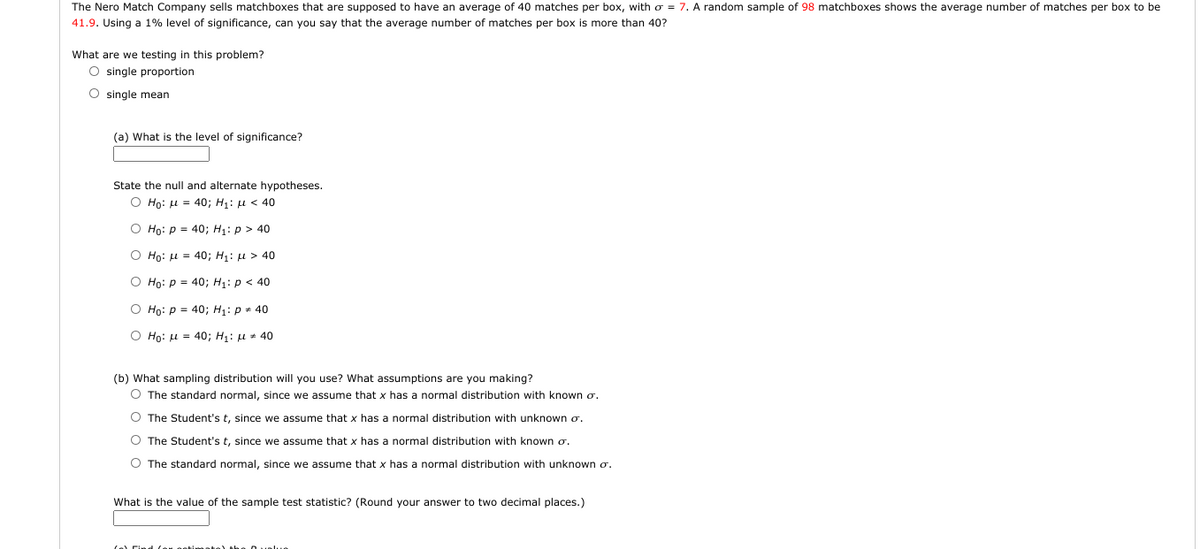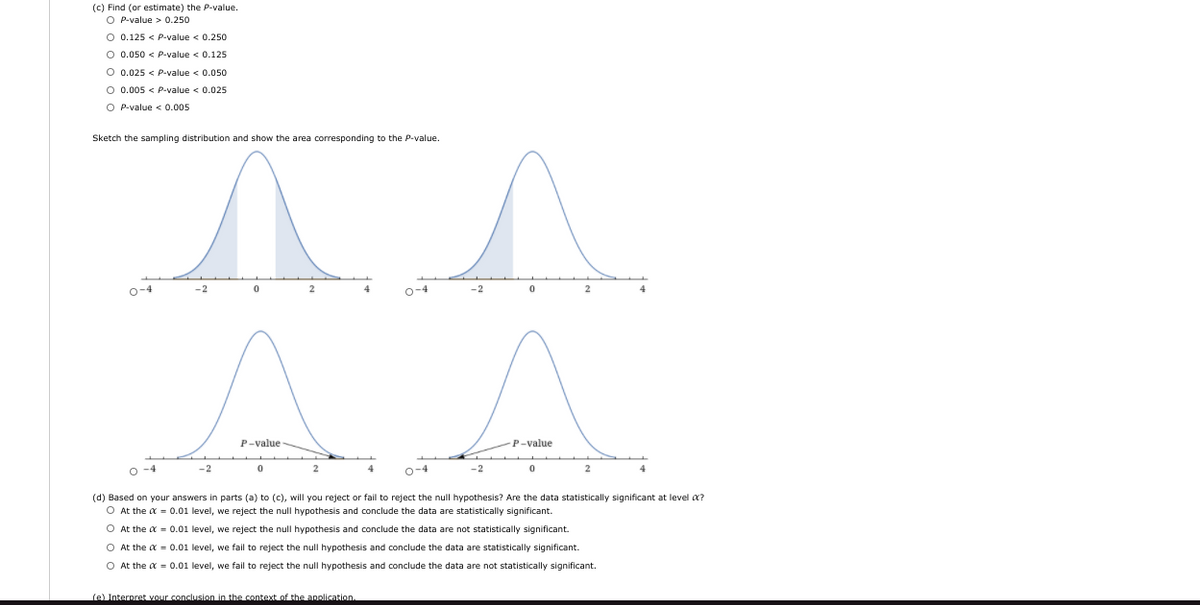The Nero Match Company sells matchboxes that are supposed to have an average of 40 matches per box, with o = 7. A random sample of 98 matchboxes shows the average number of matches per box to be 41.9. Using a 1% level of significance, can you say that the average number of matches per box is more than 40? What are we testing in this problem? O single proportion O single mean (a) What is the level of significance? State the null and alternate hypotheses. O Ho: H = 40; H: u < 40 O Ho: p = 40; H;: p > 40 Ο Hρ μ= 40; Η: μ > 40 O Ho: p = 40; Hạ: p < 40 O Họ: p = 40; H;: p- 40 O Ho: H = 40; H: u- 40 (b) What sampling distribution will you use? What assumptions are you making? O The standard normal, since we assume that x has a normal distribution with known o. O The Student's t, since we assume that x has a normal distribution with unknown o. O The Student's t, since we assume that x has a normal distribution with known o. O The standard normal, since we assume that x has a normal distribution with unknown o. What is the value of the sample test statistic? (Round your answer to two decimal places.)
The Nero Match Company sells matchboxes that are supposed to have an average of 40 matches per box, with o = 7. A random sample of 98 matchboxes shows the average number of matches per box to be 41.9. Using a 1% level of significance, can you say that the average number of matches per box is more than 40? What are we testing in this problem? O single proportion O single mean (a) What is the level of significance? State the null and alternate hypotheses. O Ho: H = 40; H: u < 40 O Ho: p = 40; H;: p > 40 Ο Hρ μ= 40; Η: μ > 40 O Ho: p = 40; Hạ: p < 40 O Họ: p = 40; H;: p- 40 O Ho: H = 40; H: u- 40 (b) What sampling distribution will you use? What assumptions are you making? O The standard normal, since we assume that x has a normal distribution with known o. O The Student's t, since we assume that x has a normal distribution with unknown o. O The Student's t, since we assume that x has a normal distribution with known o. O The standard normal, since we assume that x has a normal distribution with unknown o. What is the value of the sample test statistic? (Round your answer to two decimal places.)
Glencoe Algebra 1, Student Edition, 9780079039897, 0079039898, 2018
18th Edition
ISBN:9780079039897
Author:Carter
Publisher:Carter
Chapter10: Statistics
Section10.6: Summarizing Categorical Data
Problem 30PPS
Related questions
Topic Video
Question

Transcribed Image Text:The Nero Match Company sells matchboxes that are supposed to have an average of 40 matches per box, with o = 7. A random sample of 98 matchboxes shows the average number of matches per box to be
41.9. Using a 1% level of significance, can you say that the average number of matches per box is more than 40?
What are we testing in this problem?
O single proportion
O single mean
(a) What is the level of significance?
State the null and alternate hypotheses.
O Ho: u = 40; H1: µ < 40
O Ho: p = 40; H1: p > 40
O Ho: u = 40; H1: u > 40
O Ho: p = 40; H1: p < 40
O Họ: p = 40; H1: p + 40
O Họ: u = 40; H: u * 40
(b) What sampling distribution will you use? What assumptions are you making?
O The standard normal, since we assume that x has a normal distribution with known o.
O The Student's t, since we assume that x has a normal distribution with unknown o.
O The Student's t, since we assume that x has a normal distribution with known o.
O The standard normal, since we assume that x has a normal distribution with unknown o.
What is the value of the sample test statistic? (Round your answer to two decimal places.)

Transcribed Image Text:(c) Find (or estimate) the P-value.
O P-value > 0.250
O 0.125 < P-value < 0.250
O 0.050 < P-value < 0.125
O 0.025 < P-value < 0.050
O 0.005 < P-value < 0.025
O P-value < 0.005
Sketch the sampling distribution and show the area corresponding to the P-value.
o-4
-2
-2
AA
P-value
P-value
O -4
-2
o-4
-2
(d) Based on your answers in parts (a) to (c), will you reject or fail to reject the null hypothesis? Are the data statistically significant at level a?
O At the a = 0.01 level, we reject the null hypothesis and conclude the data are statistically significant.
O At the a = 0.01 level, we reject the null hypothesis and conclude the data are not statistically significant.
O At the a = 0.01 level, we fail to reject the null hypothesis and conclude the data are statistically significant.
O At the a = 0.01 level, we fail to reject the null hypothesis and conclude the data are not statistically significant.
(e) Interpret vour conclusion in the context of the anolication.
Expert Solution
This question has been solved!
Explore an expertly crafted, step-by-step solution for a thorough understanding of key concepts.
This is a popular solution!
Trending now
This is a popular solution!
Step by step
Solved in 2 steps with 1 images

Knowledge Booster
Learn more about
Need a deep-dive on the concept behind this application? Look no further. Learn more about this topic, statistics and related others by exploring similar questions and additional content below.Recommended textbooks for you

Glencoe Algebra 1, Student Edition, 9780079039897…
Algebra
ISBN:
9780079039897
Author:
Carter
Publisher:
McGraw Hill

Glencoe Algebra 1, Student Edition, 9780079039897…
Algebra
ISBN:
9780079039897
Author:
Carter
Publisher:
McGraw Hill